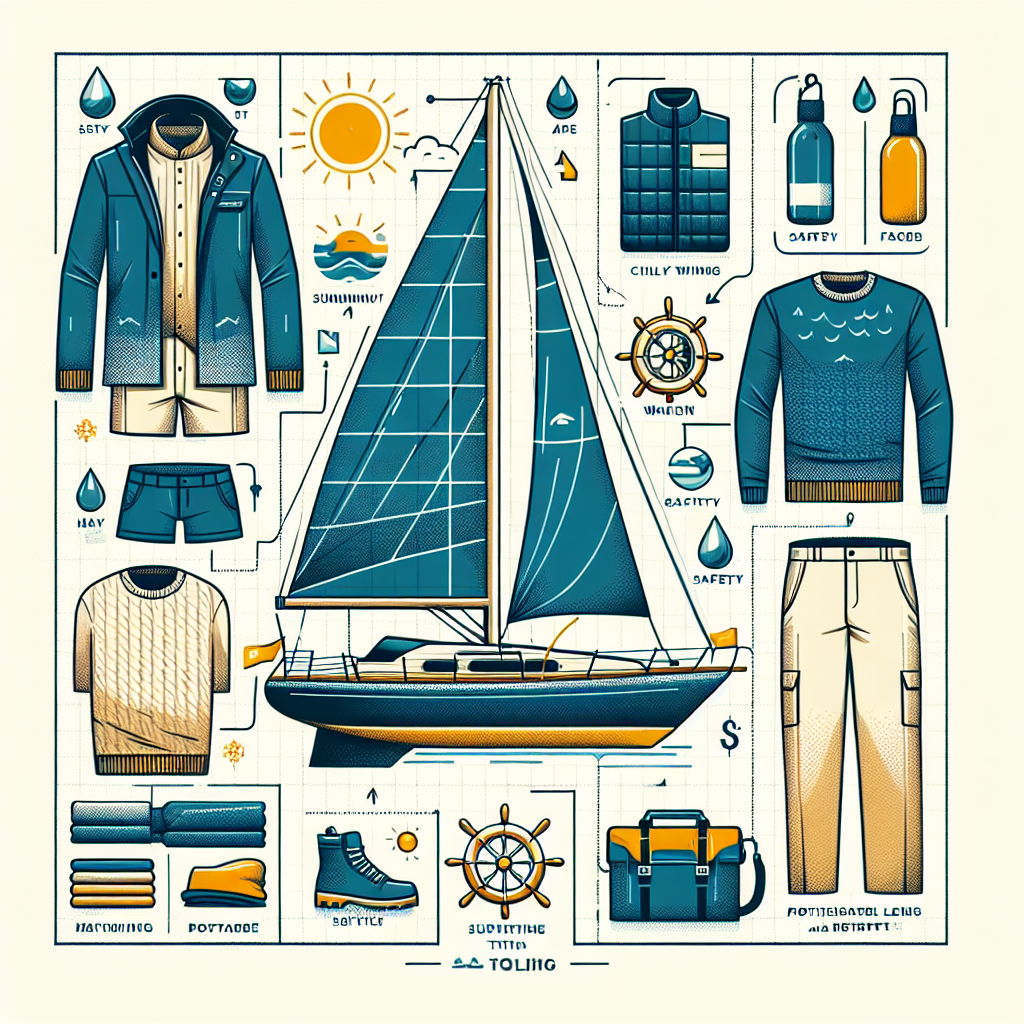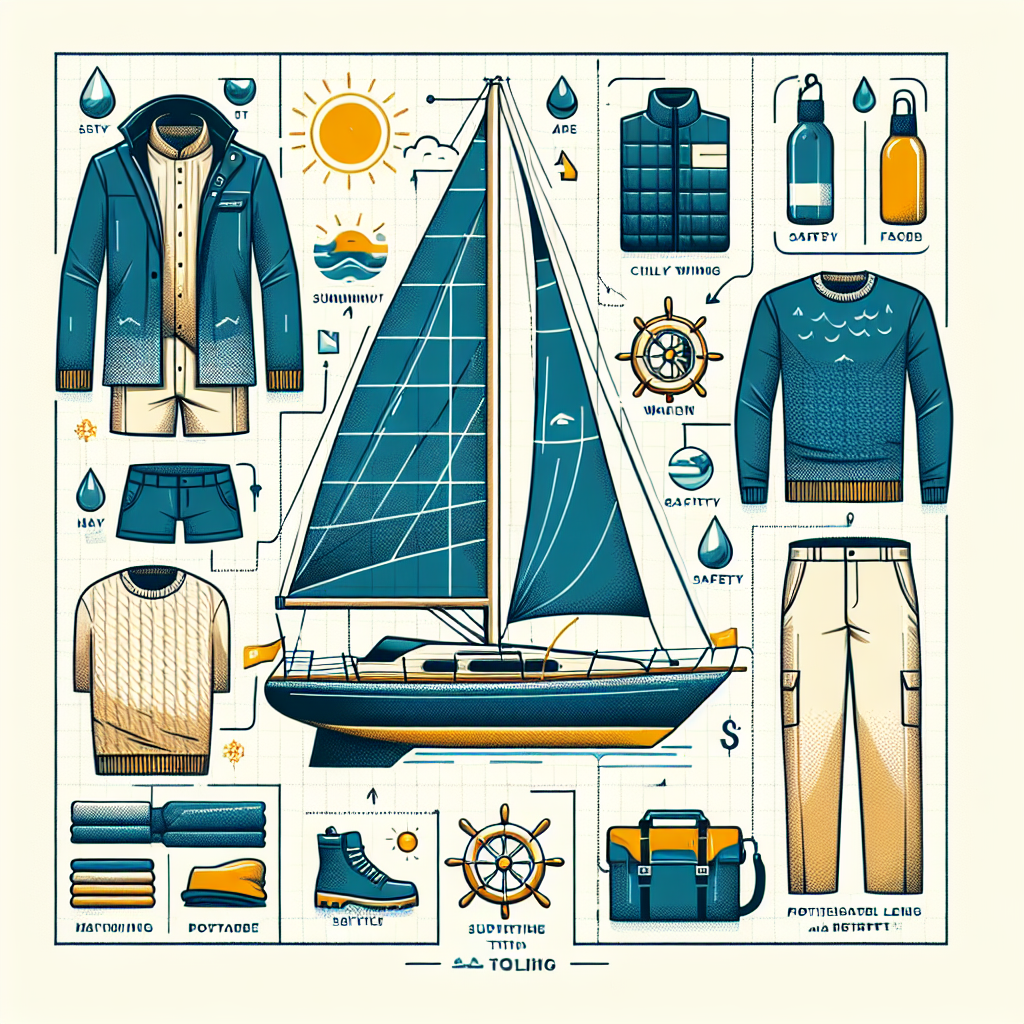What To Wear On A Sailboat: Full Guide
When embarking on a sailboat adventure, it is essential to dress appropriately to ensure comfort and safety throughout the journey. The right choice of attire can make all the difference in the world, allowing you to fully enjoy the open sea while staying prepared for any unforeseen circumstances that may arise.
In this article, we will provide you with expert guidance on what to wear on a sailboat, encompassing practicality, functionality, and style. Whether you’re a seasoned sailor or a first-time enthusiast, this comprehensive guide will help you make informed decisions regarding your onboard outfit. So, let’s set sail and explore the art of dressing for the waves.
Understanding the Sailboat Atmosphere
When embarking on a sailing adventure, it is essential to understand the unique atmosphere of a sailboat. Unlike other forms of transportation, sailing offers a sense of tranquility, freedom, and connection with nature. The sound of the wind in the sails, the gentle rocking of the boat, and the vast expanse of the open water create a serene and peaceful environment.
Types of Sailboats and Their Characteristics
Before delving into the appropriate apparel for sailing, it is crucial to familiarize yourself with the different types of sailboats and their characteristics. Sailboats can vary in size, design, and purpose.
Some common types include cruising sailboats, racing sailboats, catamarans, and dinghies. Each type has unique features that cater to specific needs, whether it be comfort for long journeys or speed for competitive racing.
Common Weather Conditions on a Sailboat
Weather conditions play a significant role in determining the type of clothing required while sailing. Being aware of the typical weather patterns in your sailing destination is crucial for selecting appropriate apparel.
Keep in mind that weather conditions can change rapidly at sea, so it is essential to be prepared for various scenarios.
Physical Activities Involved in Sailing
Sailing involves various physical activities that may impact the choice of clothing. From hoisting sails to navigating through waves, being on a sailboat requires flexibility, freedom of movement, and the ability to handle the elements. Understanding the physical demands of sailing will assist in selecting clothing that allows for ease of movement and comfort.
Sailboat Apparel Basics
When it comes to sailboat apparel, functionality takes precedence over fashion. While it is important to look presentable, the primary focus should be on clothing that serves its purpose in a sailboat environment.
Comfort and Mobility
Comfort and mobility are key factors when choosing sailboat attire. Opt for clothing that allows a full range of movement and does not restrict your ability to perform tasks on the boat. Loose-fitting clothing made from lightweight, breathable materials is ideal for comfort and maneuverability.
Layering for Changing Temperatures
Layering is essential when preparing for changing temperatures on a sailboat. The weather can fluctuate significantly throughout the day, and having multiple layers of clothing allows for easy adjustments.
Start with a moisture-wicking base layer to keep your skin dry, add insulating mid-layers for warmth, and finish with a waterproof outer layer to protect against wind and rain.
Importance of Sun Protection
Sun protection is crucial when spending extended periods of time on a sailboat. The combination of water and sun exposure increases the risk of sunburn and long-term skin damage.
Wearing appropriate clothing that covers exposed skin, such as long-sleeved shirts and pants, along with a wide-brimmed hat and sunglasses, is essential to safeguard your skin from harmful UV rays.
Clothing Materials Suitable for Sailing
Choosing the right materials for sailboat clothing is vital to ensure comfort and durability in the sailing environment.
Understanding Quick-Drying Fabrics
Quick-drying fabrics are a must-have for sailboat apparel. These materials, such as synthetic blends or merino wool, wick moisture away from the body, preventing the build-up of sweat. Quick-drying fabrics allow for faster evaporation, keeping your body dry and comfortable, even in humid conditions.
Benefits of Breathable Materials
Breathable materials, such as nylon or polyester, promote air circulation, allowing heat and moisture to escape. This feature is particularly important in warm weather or during strenuous activities on the boat. Breathable fabrics help prevent overheating and maintain comfort during long hours of sailing.
Durability and Wind Resistance
Sailboat clothing should be made from durable materials that can withstand the challenges of sailing. The clothing must be able to withstand wind, saltwater exposure, and potential friction from ropes and equipment. Look for reinforced seams and wind-resistant fabrics to ensure longevity and protection in the sailing environment.
Essential Sailboat Clothing Items
While sailboat attire may vary depending on the specific sailing conditions, some clothing items are considered essential for any sailing adventure.
Wicking Base Layers
Starting with a moisture-wicking base layer is essential for maintaining comfort on a sailboat. Base layers keep the skin dry by pulling perspiration away from the body. Opt for lightweight, quick-drying materials that provide moisture management to help regulate body temperature.
Insulating Mid-Layers
Insulating mid-layers is crucial for maintaining warmth in colder temperatures or during night sailing. Fleece jackets or lightweight down jackets are excellent choices for providing insulation while still being breathable and allowing for a wide range of motion.
Waterproof Outer Layers
A waterproof outer layer is the final line of defense against wind, rain, and waves. A good-quality waterproof jacket and pants will protect you from water splashes and help keep you dry in inclement weather. Look for waterproof garments that also have breathability features to prevent condensation and moisture build-up.

Ideal Footwear for Sailboats
Choosing the right footwear for sailing is important for stability, comfort, and safety on board.
Sailing Shoes and Boots Considerations
Sailing shoes and boots should have non-marking soles to prevent scuffs or marks on the boat. They should also offer good traction to prevent slipping on wet surfaces. Look for shoes with toe protection and ankle support to guard against potential injuries while moving around the boat.
Avoiding Traditional Sandals and Flip Flops
Traditional sandals and flip-flops are not suitable for sailboat activities. They provide little to no protection from sharp objects, offer limited grip on wet surfaces, and can easily slip off in rough conditions. Opt for closed-toe water shoes or deck shoes that provide grip, stability, and protection.
Choosing Non-Slip and Water-Resistant Options
Non-slip and water-resistant footwear is essential for maintaining stability and preventing accidents on a sailboat. Shoes or boots with rubber soles that offer excellent traction on wet surfaces are highly recommended. Additionally, water-resistant materials will help keep your feet dry and comfortable throughout your sailing journey.
Protective Accessories for Sailing
In addition to the appropriate clothing, certain accessories are essential for protecting yourself while sailing.
Hats and Caps for Sun Protection
Hats and caps that provide ample coverage are essential for protecting your face, neck, and ears from the sun’s harmful rays. Opt for wide-brimmed hats or caps with neck flaps to shield yourself from direct sunlight. Additionally, wearing a hat can help prevent heatstroke by keeping your head cool.
Sunglasses and UV Protection
Investing in a pair of sunglasses with UV protection is crucial when spending long hours on a sailboat. The reflection of sunlight on the water intensifies UV exposure, increasing the risk of eye damage. Look for sunglasses with polarized lenses that effectively block harmful UV rays while reducing glare from the water’s surface.
Gloves for Gripping and Handling
Gloves are a key accessory for sailing, as they help grip ropes and equipment, protect hands from blisters and calluses, and provide insulation in cold weather. Look for sailing-specific gloves made from durable materials that offer good grip and dexterity, allowing you to handle tasks with ease and comfort.

Navigating Extreme Weather Conditions
Sailing conditions can become challenging in extreme weather environments. Being prepared for these conditions with appropriate clothing is essential for your safety and comfort.
Rain Gear for Sailing
Investing in high-quality rain gear is a must for sailing expeditions. Waterproof jackets and pants with sealed seams will keep you dry during heavy rain or rough sea conditions. Look for gear that is also breathable to prevent excessive sweating and discomfort.
Cold Weather Clothing Recommendations
Sailing in cold weather requires specialized clothing to protect against the elements. Layer up with thermal base layers, insulating mid-layers, and a windproof, waterproof outer layer. Additionally, consider wearing a hat and gloves designed for cold weather conditions to prevent frostbite and maintain warmth.
Dealing with Heat and Sun Exposure
When sailing under intense heat and sun exposure, it is crucial to prioritize sun protection and stay hydrated. Wear lightweight, breathable clothing that provides adequate coverage, including long-sleeved shirts and pants. Additionally, use sunscreen with a high sun protection factor (SPF) and reapply regularly to ensure optimal protection.
Night Sailing and Visibility
Night sailing requires additional attention to visibility and safety precautions.
Layering for Lower Temperatures
During nighttime, temperatures often drop, necessitating appropriate clothing layers for warmth. Layering up with insulating mid-layers and a windproof outer layer will help retain body heat and keep you comfortable during cooler nighttime conditions.
Importance of Reflective Clothing
Wearing reflective clothing is crucial for night sailing, as it enhances visibility and ensures that you are easily seen by other vessels. Look for jackets or vests with reflective strips to increase your visibility on the water, minimizing the risk of accidents.
Using Light and Glow Equipment
Carrying glow sticks or attaching lights to your clothing or accessories is highly recommended for night sailing. These additional light sources improve your visibility to others and make it easier to navigate the boat during low-light conditions.

Dressing for Dive Recovery and Man Overboard Situations
Preparing for potential dive recovery or man-overboard situations requires specific clothing considerations.
Wearing Bright Colors for Visibility
Wearing bright-colored clothing significantly improves visibility in the event of a dive recovery or man overboard situation. Choose clothing in vibrant colors such as neon yellow, orange, or red to make it easier for rescue teams to locate you in the water.
Benefits of Quick-Dry Clothing in Water Recovery
In situations where you may end up in the water, wearing quick-dry clothing is advantageous. Quick-drying materials will help prevent excessive water absorption, allowing you to remain comfortable and retain body heat in case of extended exposure to water.
Considering Floatation Devices and Emergency Equipment
As part of your sailboat attire, ensure you have the necessary floatation devices and emergency equipment readily available. Life jackets, throw ropes, and other safety equipment should be easily accessible and properly maintained to facilitate swift response and enhanced safety during emergencies.
Additional Tips and Common Mistakes
To ensure a comfortable and safe sailing experience, consider the following tips and avoid common mistakes.
Avoiding Cotton and Denim Materials
Cotton and denim materials should be avoided while sailing, as they absorb water and do not dry quickly. Wet cotton clothing can cause discomfort, chafing, and even hypothermia in cold weather conditions. Opt for quick-drying synthetic fabrics or merino wool instead.
Avoiding Loose and Baggy Clothing
Loose and baggy clothing can pose safety risks on a sailboat. Excess fabric can get caught in ropes and equipment, potentially causing accidents or injuries. Choose clothing that fits snugly but still allows for freedom of movement.
Remembering to Pack Extra Layers
Always pack extra layers of clothing to anticipate changing weather conditions. Temperature shifts, rainstorms, and unexpected wind can occur while sailing. Being prepared with additional layers ensures that you can adapt to these changes and remain comfortable throughout your journey.
Importance of Trying On Gear Before Sailing
Before setting sail, try on all your gear to ensure a proper fit. Ill-fitting clothing or footwear can lead to discomfort, chafing, and hindered movement. Testing and adjusting your gear ahead of time allow for necessary modifications or replacements, ensuring a seamless sailing experience.
In conclusion, understanding the sailboat atmosphere and choosing appropriate clothing are crucial for an enjoyable and safe sailing experience. Prioritize functionality, comfort, and protection against the elements when selecting sailboat apparel.
With the right clothing materials, footwear, and accessories, you can fully immerse yourself in the sailboat atmosphere and make the most of your sailing adventure.












